I have been, or can be if you click on a link and make a purchase, compensated via a cash payment, gift, or something else of value for writing this post. As an Amazon Associate, I earn from qualifying purchases. Please read my full Affiliate Disclosure for more information.
Have you ever felt drawn to spaces that exude calmness, imperfection, and natural beauty? Wabi-Sabi Living Room Ideas are gaining popularity because they celebrate the beauty of simplicity, authenticity, and the imperfect charm of everyday life.
In this article, you’ll explore a variety of ideas to bring tranquility and understated elegance into your living space. From rustic decor to minimalist arrangements, these concepts will inspire you to craft a serene environment that reflects your unique taste and appreciation for life’s subtle imperfections.
1. Embrace Imperfectly Chic Textured Wall Surfaces with Natural Plaster
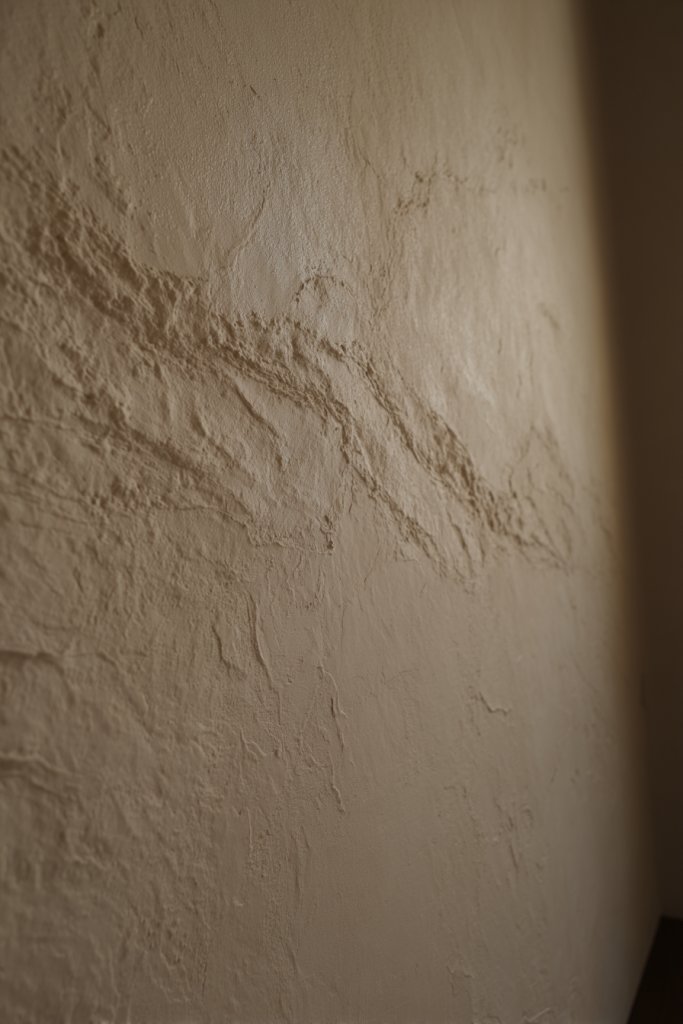
Ever felt that your living space needs more personality but you’re tired of perfect, sterile walls? The Wabi-Sabi approach invites us to celebrate the beauty of imperfection, especially in wall textures. Natural plaster offers a raw, authentic feel that instantly adds character without the fuss of flawless finishes. It’s about embracing the quirks that make your space uniquely yours.
Imagine walls with uneven, textured surfaces that catch the light in subtle ways, revealing gentle ridges and valleys. The warm, earthy tones of natural plaster create a cozy backdrop, blending seamlessly with rough-hewn wood furniture and soft textiles. The tactile quality makes you want to reach out and feel every bump and groove, bringing a sensory richness to the room. It’s like giving your walls a gentle, imperfect hug.
This textured wall idea works in both modern minimalist spaces and rustic cabins. For a cozy winter vibe, layer with warm-toned textiles and thick rugs. In warmer months, pair with light linen curtains and airy furniture to keep things fresh. You can also experiment with different plaster techniques, from smooth-to-rough finishes, to match your personal style and space constraints. The key is to balance the rustic charm with your room’s overall aesthetic.
Start by choosing high-quality natural plaster or lime render, which you can apply yourself with basic tools like trowels and sponges. Prepare your wall surface by cleaning and priming it thoroughly. Use a trowel to spread the plaster unevenly, embracing the natural ridges and imperfections. Once dry, lightly sand or leave as-is for more texture. Seal with a matte, breathable finish to preserve the organic look. Remember, the beauty lies in the irregularities, so don’t aim for perfection.
Add subtle color variations by mixing natural pigments into the plaster—think soft ochres or muted greys. Incorporate sculptural elements like handmade clay tiles or textured wall panels nearby to echo the tactile theme. Use lighting strategically to highlight the textured surface, casting gentle shadows that emphasize every bump. Personal touches like vintage frames or handcrafted mirrors can also complement the organic aesthetic without overpowering it.
Natural plaster walls remind us that imperfection has its own charm and beauty. They create a warm, inviting atmosphere that evolves with time, gaining character. Trust in the process and celebrate the irregularities—they’re what make your space truly one-of-a-kind. Ready to give your walls a soulful, imperfect charm that’s both timeless and modern?
2. Incorporate Raw Wood Furniture with Weathered Finishes for Authenticity
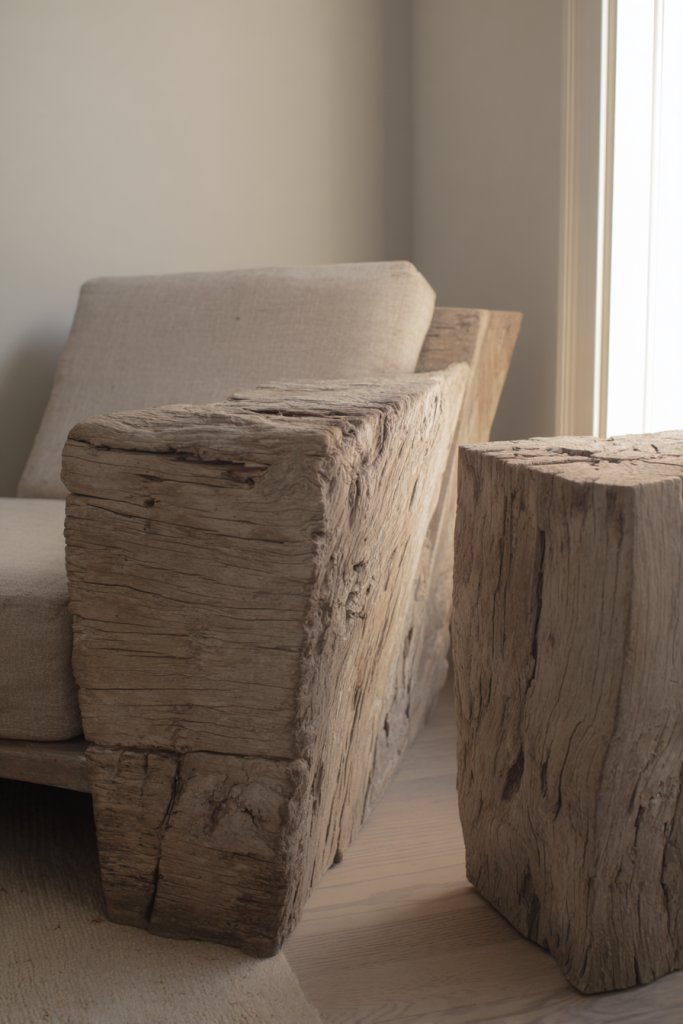
Does your living room feel a bit too polished or clinical? Raw, weathered wood furniture instantly adds a sense of authenticity and warmth that’s hard to beat. It’s perfect for those craving a space that feels lived-in and genuine, not just styled for Instagram. Plus, these pieces age gracefully, gaining character over time.
Picture a sturdy coffee table with chipped paint and a rough, matte finish, paired with a vintage armchair with peeling upholstery. The grain of the wood is visible, with knots and cracks adding to its rustic charm. The furniture looks like it’s been through decades of family gatherings, yet it still holds its charm and function. The weathered surface invites touch and tells a story of history and patience.
Weathered wood fits perfectly in both coastal, farmstead, or industrial-inspired interiors. For a softer look, combine with plush cushions and cozy throws. In a more modern space, pair with sleek metal accents or minimalist textiles for contrast. You can also incorporate smaller weathered accents like picture frames or side tables to create cohesion without overwhelming the room. Seasonally, layer with fresh linens or cozy wool blankets to change the vibe.
Start sourcing reclaimed or sustainably harvested wood furniture—look for pieces with visible wear, peeling paint, or distressed surfaces. If you prefer DIY, lightly sand and clear coat existing furniture to enhance the weathered look. Mix different wood tones for a curated, eclectic feel, or stick to one for visual harmony. Maintain the aged look by avoiding over-polishing; instead, embrace natural patina and imperfections. Incorporate these pieces into your space, balancing rustic charm with modern comfort.
Personalize with hand-painted details or subtle carvings to amplify the rustic vibe. Use vintage textiles or woven cushions to complement the weathered finish. Add a few well-chosen accessories like old books or antique trays to reinforce the story of age and use. Consider also pairing with a soft, plush rug to soften the overall look while maintaining authenticity. Let your furniture tell your personal history.
Weathered wood furniture embodies the Wabi-Sabi ethos—beauty in imperfection and aging gracefully. It creates a cozy, inviting space that feels authentic and relaxed. Over time, these pieces develop a unique patina that no new furniture can replicate. Embrace the imperfect charm, and your space will feel more genuine and grounded—perfect for long-term comfort and style.
3. Use Neutral Tones and Subtle Variations in Fabric for Cozy, Unpretentious Seating

Tired of loud, busy upholstery that clashes with your calming space? Neutral tones and gentle fabric variations create a soothing environment that invites relaxation without overwhelming. It’s about cultivating a space where you can unwind and feel grounded, even after a hectic day. Plus, these fabrics age beautifully, adding to the room’s character.
Imagine a soft, cream-colored linen sofa with natural linen texture visible under the light. Toss in cushions in muted taupe and warm beige, with subtle weave patterns that add depth. The fabric’s understated variations create a sense of movement, making the furniture look effortlessly inviting. The overall palette keeps the space calm, balanced, and timeless. It’s like wrapping yourself in a cozy, quiet embrace.
This approach suits almost any space, from coastal retreats to urban apartments. For winter, layer with chunky knits and wool throws in similar neutral shades. During warmer months, add light cotton or linen slipcovers and removable cushion covers for easy refreshes. Mix textures like boucle, chambray, or raw silk for subtle visual interest without breaking the calm. Keep the color palette simple for maximum serenity.
Choose fabrics that breathe and age well, such as linen, cotton, or hemp blends. When selecting upholstery, opt for natural, undyed fibers to keep the look authentic. Use neutral-colored thread for sewing to maintain a seamless appearance. To add variation, incorporate fabric weaves with different textures—think smooth, nubby, or subtly ribbed. Regularly rotate cushions and wash removable covers to maintain softness and freshness.
Add personal touches with handmade cushions in similar tones, perhaps with subtle embroidery or textured trims. Incorporate layered textiles like a soft wool throw or linen curtains to enhance the cozy feel. Use natural fiber rugs underneath for tactile richness and warmth. Keep accessories minimal but meaningful—think a handcrafted ceramic bowl or a woven basket—avoiding clutter to preserve tranquility.
Using neutral fabrics creates a timeless, calming space that evolves gracefully with your style. It’s easy to refresh by swapping out textiles seasonally or adding new textures. The understated palette allows your personal decor to shine without competing. Trust in the simplicity and let your space become a sanctuary of understated elegance and comfort.
4. Showcase Handmade Ceramics and Earthenware for a Rustic Touch
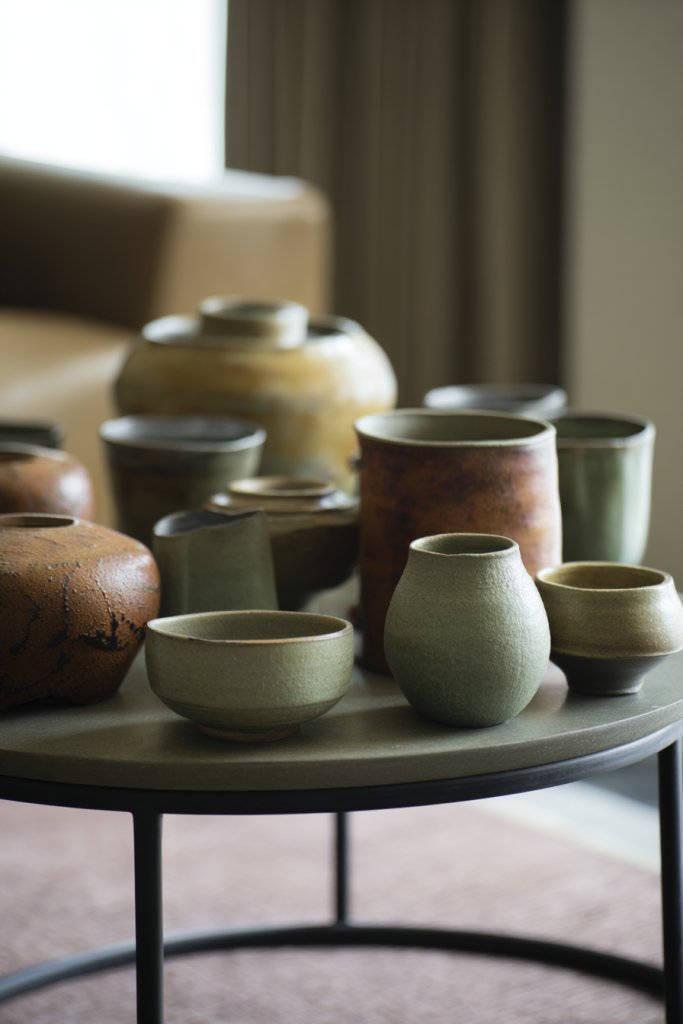
Looking to add a handcrafted, earthy vibe to your living room without going overboard? Handmade ceramics and earthenware effortlessly introduce a rustic charm that’s warm and genuine. They’re perfect for those who appreciate craftsmanship and want their space to feel curated, not mass-produced. Plus, every piece has its own story and quirks.
Picture a collection of textured ceramic bowls and vases with uneven glazes in earthy tones—warm terracotta, soft cream, muted greys. These pieces sit on open shelving or atop wooden side tables, catching the light with their matte finish. The tactile surfaces invite touch, while their irregular shapes add visual interest. The overall effect is a cozy, artisanal aesthetic that feels both relaxed and refined.
In minimal settings, a few statement pieces—like a large, textured vase—can serve as focal points. For more layered looks, mix different shapes and sizes, creating a small ceramic collection. For seasonal updates, pair with natural textiles or raw wood accents. These ceramics work beautifully in both modern and traditional interiors, adding authenticity and texture.
Start by sourcing handmade ceramics from local artisans or online craft markets. When choosing, look for pieces with visible brush strokes or glaze variations—these are signs of craftsmanship. Incorporate them as standalone decor or functional items, like bowls filled with seasonal fruits or small sculptures. Avoid overloading surfaces; instead, let each piece breathe. Regularly clean with a soft cloth to preserve their matte finish.
Personalize your collection with custom pieces or vintage finds. Combine with natural textiles like linen or wool for a layered look. Incorporate plant hangers or small earthenware planters (though avoiding actual plants if restricted) to extend the earthy theme. Display with intention, creating vignettes that tell a story of craftsmanship and natural beauty.
Handmade ceramics embody the imperfect beauty that Wabi-Sabi celebrates. They bring a warm, tactile element that elevates any space. Over time, your collection becomes more personal and meaningful. Trust the craftsmanship and enjoy how these pieces age gracefully, adding character and soul to your living room.
5. Integrate Low, Simplistic Shelving for Uncluttered and Calm Storage
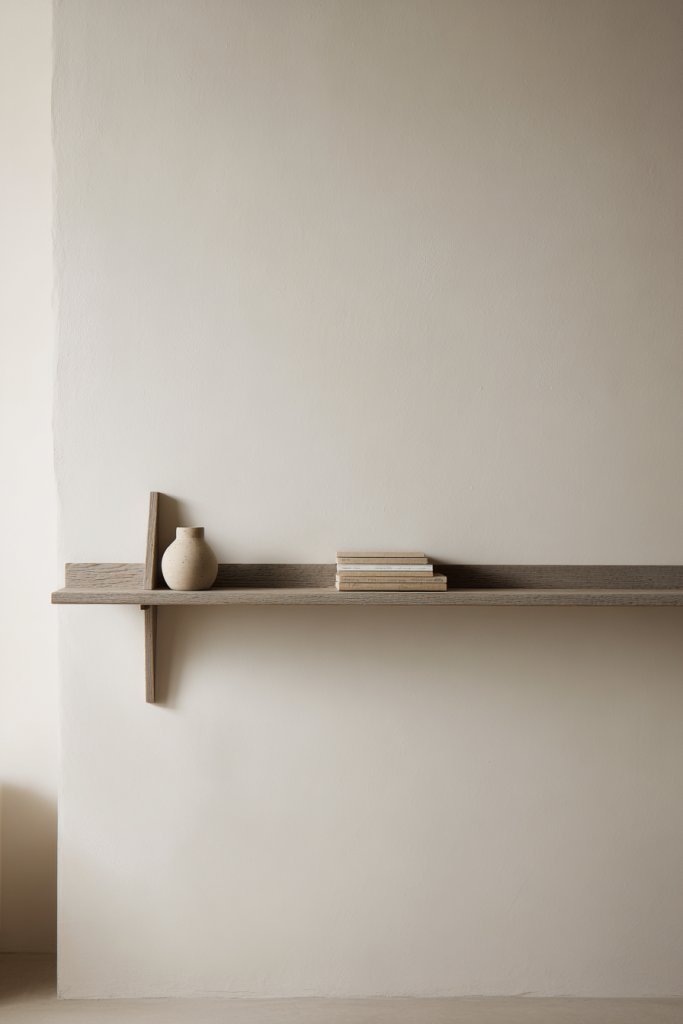
Clutter can turn a peaceful space into chaos in seconds. Low, simplistic shelving offers a clean, unobtrusive way to organize essentials without sacrificing style. It’s about creating a calm, intentional space where everything has a place—yet nothing feels overwhelming. Perfect for those who crave order with an aesthetic touch.
Envision thin, matte-finished wooden shelves mounted close to the wall, holding curated collections of handmade ceramics, books stacked horizontally, and small sculptural objects. The low profile keeps the eye focused on the room’s overall harmony. The shelves blend seamlessly with neutral wall tones, adding subtle architectural interest. The open design invites visual flow and easy access to stored items.
In small spaces, use floating shelves to maximize vertical space. For larger rooms, combine open shelving with hidden storage units for a balanced look. For seasonal refreshes, swap decor items or add textiles like woven baskets or fabric-lined boxes. The key is to keep the display simple, highlighting a few meaningful objects rather than cluttering with everything.
Choose slim, sturdy wood or metal brackets that support minimalist shelves. Mount them securely into wall studs for safety, and keep the shelves low for easy access and visual grounding. Decorate with a few selected items—think textured pottery, vintage trinkets, or natural fiber baskets. Regularly declutter to maintain a serene environment. Incorporate lighting like hidden LED strips or wall sconces to highlight the shelves without creating visual clutter.
Personalize your shelves with heirlooms, handmade crafts, or favorite books (if permitted). Use fabric-lined baskets for hidden storage to keep things tidy. Incorporate sculptural elements like wooden or ceramic pieces that add depth. Keep the arrangement balanced and intentional, avoiding overcrowding to preserve the calm aesthetic.
Low, simple shelving proves that less is more. It offers a flexible way to showcase your personality subtly. Over time, curated displays evolve, becoming a reflection of your taste and journey. Trust in minimalist storage to keep your space uncluttered and peaceful, making your home a true sanctuary.
6. Opt for Uneven, Organic-Shaped Rugs to Add Warmth and Character
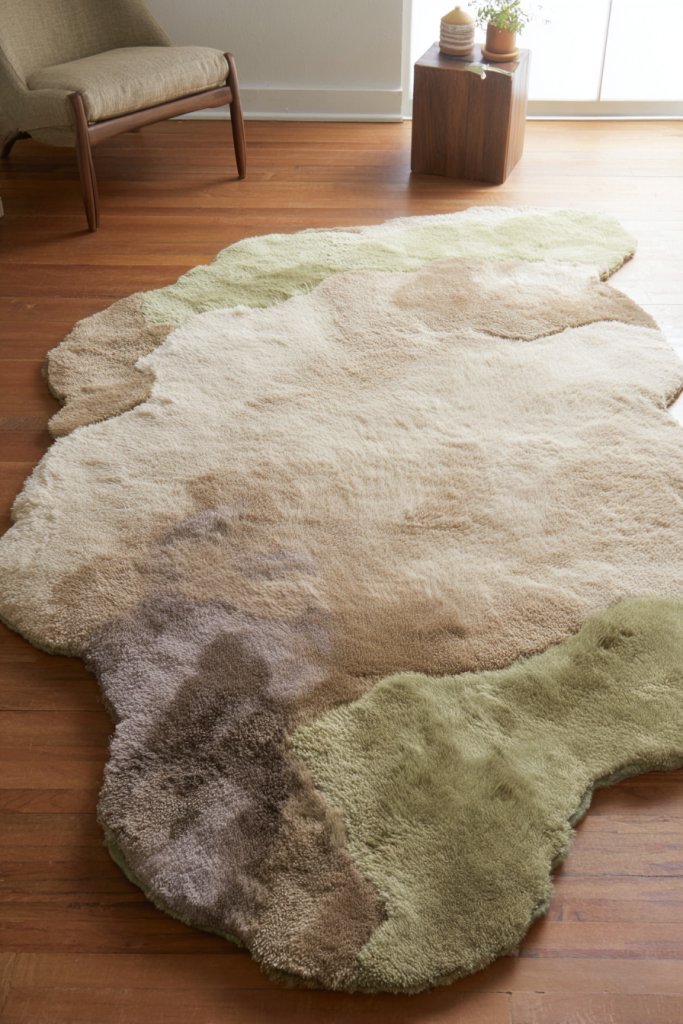
A perfectly symmetrical rug might look nice, but it often feels a bit too staged. Uneven, organic-shaped rugs bring warmth and a touch of nature into your space, creating a relaxed, welcoming vibe. They’re perfect if you want your floors to feel more alive and less predictable. Plus, their irregular shapes hide stains and wear better over time.
Visualize a large, irregularly shaped jute or wool rug, with uneven edges that mimic the natural contours of a leaf or pebble. The textured fibers add depth and tactile interest, inviting barefoot walks. The muted earth tones complement neutral furniture, tying the room together with subtle harmony. The irregular shape breaks up straight lines, creating a more organic, free-flowing environment.
Choose a rug with natural fibers like sisal, jute, or wool for durability and texture. In small spaces, a single organic rug can define a seating area or workspace. For larger rooms, layer with smaller, similarly shaped rugs for added depth. Seasonal styling includes adding woven throws or textured cushions to echo the tactile theme without cluttering.
Pick a rug with irregular, organic edges that fits your space, considering size and scale. Place it on a smooth, clean floor surface for maximum effect. Keep it simple: avoid over-layering with other rugs, which can disrupt the natural flow. Vacuum regularly to maintain the fibers’ softness and appearance. Consider adding a non-slip pad underneath for safety and longevity. The goal is to create a natural, effortless grounding for your furniture.
Coordinate with your upholstery and textiles in neutral, earthy shades to enhance the organic vibe. Add textured cushions or throws that mimic the rug’s tactile quality. Incorporate natural wood or stone accents nearby for a cohesive look. The irregular rug acts as a grounding element that unifies your space and invites a sense of calm.
Organic-shaped rugs remind us that beauty often lies in imperfection. They bring a grounded, earthy warmth that evolves with your space. Over time, they develop a patina that adds even more character. Trust in their natural charm to create a space that feels both relaxed and thoughtfully curated.
7. Select Minimalist Lighting with Soft, Diffused Glow Using Paper or Fabric Shades
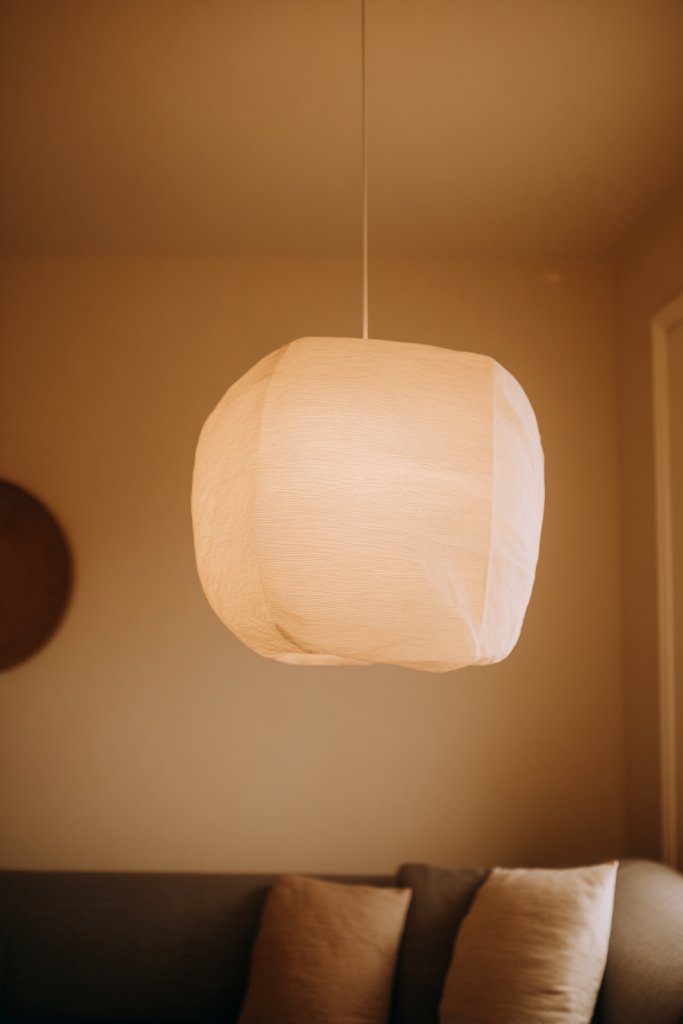
Harsh lighting can ruin the calm vibe you’re trying to cultivate. Minimalist lighting with soft, diffused glow creates a gentle ambiance that soothes your senses. It’s about avoiding glare and instead bathing your space in warm, inviting light. Perfect for winding down after a busy day or creating an intimate atmosphere.
Picture a simple paper lantern or fabric-shaded pendant hanging from the ceiling, emitting a warm, even glow. The shades diffuse the light softly, casting gentle shadows and emphasizing textures in the room. Nearby, a wall-mounted sconce with a fabric or rice paper shade adds layers of ambient light. The result is a cozy, serene environment that beckons you to relax and stay awhile.
Choose shades in neutral tones like off-white, beige, or muted earth hues to keep the calm aesthetic. For different seasons, swap in shades with subtle patterns or textures—think crinkled paper or woven fabric. Use dimmers to control the light intensity, adapting the mood for different times of day or activities. Incorporate candles or string lights for additional subtle lighting options.
Select fixtures with simple, clean designs that can hold paper, fabric, or rice paper shades. Mount wall sconces at eye level to create a layered lighting effect. Use LED bulbs with warm color temperatures to enhance the soft glow and energy efficiency. Install dimmers for maximum control, and position fixtures to highlight textures and architectural features. Regularly clean shades to keep the light diffuse and inviting.
Customize shades with natural fabrics or painted patterns for a personal touch. Incorporate small table or floor lamps with fabric shades for flexible lighting options. Use diffused lighting to accentuate textured wall surfaces or textiles, creating depth and warmth. Layer lighting sources to build a cozy, multi-dimensional environment that adapts to your mood.
Soft, diffused lighting transforms your space into a sanctuary of calm. It helps you disconnect from harsh realities and reconnect with serenity. Small adjustments in lighting can dramatically change the atmosphere, making your home more inviting. Embrace simple, elegant fixtures—they’re timeless and versatile, perfect for any Wabi-Sabi-inspired space.
8. Arrange Organic, Asymmetrical Arrangements of Natural Elements like Stones or Driftwood

Feeling like your decor is too symmetrical or staged? Asymmetrical arrangements of natural elements bring a spontaneous, organic feel that’s authentic and calming. They evoke a sense of natural harmony and remind us that beauty often lies in imperfection. It’s a simple way to add visual interest without clutter.
Visualize a collection of smooth stones stacked unevenly or a driftwood branch placed deliberately off-center on a low shelf. The irregular shapes and textures introduce a tactile, earthy vibe that feels rooted in nature. These elements can be combined with simple textiles or handcrafted ceramics to create a curated yet relaxed display. The overall effect is a calming, imperfect natural vignette.
You can create a focal point with a sculptural piece, like a large stone or a twisted root. For seasonal updates, add dried grasses or branches, or switch between smooth and rough textures. Place these arrangements on low tables, windowsills, or as centerpiece accents on dining tables. Keep the layout intentionally asymmetrical to emphasize natural irregularity.
Gather elements from nature—stones, driftwood, dried branches—preferably from local environments for authenticity. Arrange them in a way that feels unforced but balanced, avoiding perfect symmetry. Use simple bowls or trays to contain and display them neatly. Periodically clean and refresh the arrangements, swapping elements for new finds or seasonal changes. The goal is to evoke nature’s unpredictable beauty.
Personalize with engraved stones or painted driftwood for a unique touch. Incorporate textured textiles nearby, like woven mats or rustic cloths, to complement the natural elements. Create a small focal point by grouping a few larger pieces together, or scatter smaller stones for a more casual look. The key is to keep the arrangement feeling effortless and alive.
Natural, asymmetrical arrangements remind us that imperfections are beautiful. They create a space that feels grounded and authentic. Over time, these elements develop a patina that adds to their charm. Trust the process and enjoy the calming influence of organic, imperfect decor—your space will feel more alive and personal.
9. Create a Focal Point with a Single, Wabi-Sabi-Inspired Art Piece in Earth Tones
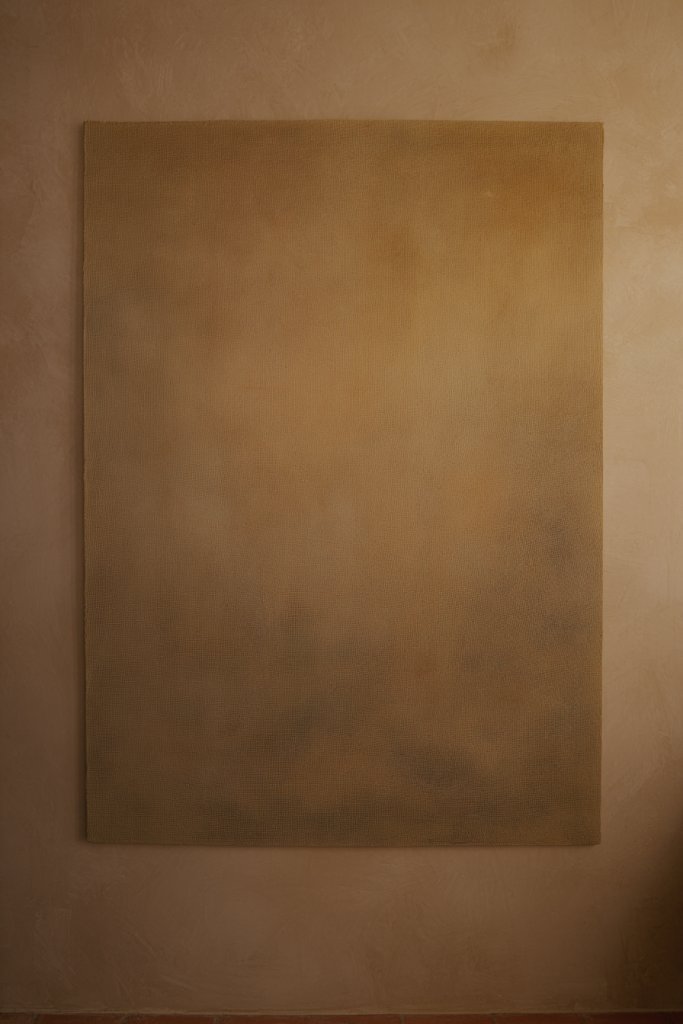
Do your walls feel empty or overly busy? A single, carefully chosen art piece can serve as a powerful focal point that anchors your space. Wabi-Sabi art emphasizes simplicity and earth tones, creating a calming visual anchor that promotes tranquility. It’s about finding beauty in the understated, not the overstated.
Imagine a large, handmade ceramic or wood sculpture with natural textures and muted, earthy hues—rusty reds, warm browns, soft greys. The piece is imperfect in shape, with visible brush strokes or natural grain that highlights craftsmanship. Placed on a plain wall or atop a simple pedestal, it draws the eye and invites quiet contemplation. The overall effect is soothing and centered.
Choose a piece that resonates with your personal aesthetic—whether abstract, sculptural, or minimalist. For a more layered look, pair with subtle textiles or neutral wall treatments that don’t compete. Change the art seasonally or with your mood, keeping it simple but meaningful. Position it in a spot where natural light can subtly highlight its textures and imperfections.
Select a piece that embodies your style—handmade, organic, imperfect in form. Use a simple wall mount or stand to display it prominently. Keep surrounding decor minimal to let the art breathe and command attention. To enhance the earthy aesthetic, consider natural materials like stone or wood for bases or frames. Periodically clean or reposition the piece to keep it fresh and engaging.
Personalize by choosing a piece that has personal significance or is crafted by an artist you admire. Complement it with textured textiles or simple lighting to emphasize its presence. Incorporate natural elements like stones or dried botanicals nearby to extend the earthy vibe, avoiding any clutter that distracts from the focal point. Think of this art piece as a visual meditation.
A single Wabi-Sabi-inspired art piece can transform your entire space into a sanctuary of simplicity. It reminds us that less truly is more and that beauty often resides in the humble and imperfect. Over time, it becomes a symbol of your appreciation for authenticity and craftsmanship—an anchor for your home’s soul.
10. Use Reclaimed or Repurposed Materials for DIY Decor Projects

Want to add a personal touch while being eco-friendly? Reclaimed and repurposed materials allow you to craft unique decor pieces that tell a story. It’s a satisfying way to create authentic, imperfect elements that fit perfectly into a Wabi-Sabi space. Plus, it saves money and reduces waste—win-win, right?
Visualize a coffee table made from salvaged wood with visible knots and weathered paint. Or perhaps a set of wall-mounted coat hooks crafted from old metal pipes. These pieces showcase their history through cracks, peeling paint, and textures that can’t be manufactured. They add a layered, lived-in feeling that’s both stylish and sustainable. The mix of old and new creates a rich, textured environment.
Use reclaimed wood for furniture, or old textiles for pillow covers and curtains. Repurpose vintage suitcases or crates as storage and side tables. Seasonal updates could involve adding new hardware or finishes to old pieces. These DIY projects suit rustic, industrial, or eclectic interiors and are easily tailored to your skill level.
Start by sourcing reclaimed materials from salvage yards, flea markets, or online marketplaces. Plan your project carefully, focusing on simple techniques like sanding, painting, or sealing. Use basic tools like drills, paintbrushes, and clamps. Embrace imperfections—let cracks and peeling paint show—they’re part of the charm. Finish with natural oils or matte sealants to preserve the aged look.
Add personal touches like hand-painted details, engraved initials, or layered textures. Incorporate vintage hardware or handmade handles to enhance character. Use textiles or cushions to soften hard surfaces and make them inviting. These DIY projects become meaningful, one-of-a-kind pieces that reflect your style and values.
Reclaimed and repurposed decor embodies the Wabi-Sabi philosophy—beauty in imperfection and age. They foster a sense of sustainability and authenticity that elevates your space. Over time, these pieces deepen in character, becoming treasured parts of your home. Trust your craftsmanship and enjoy creating a space with a genuine, personal story.
11. Incorporate Open-Frame, Worn Metal or Bamboo Elements for Subtle Industrial Vibes
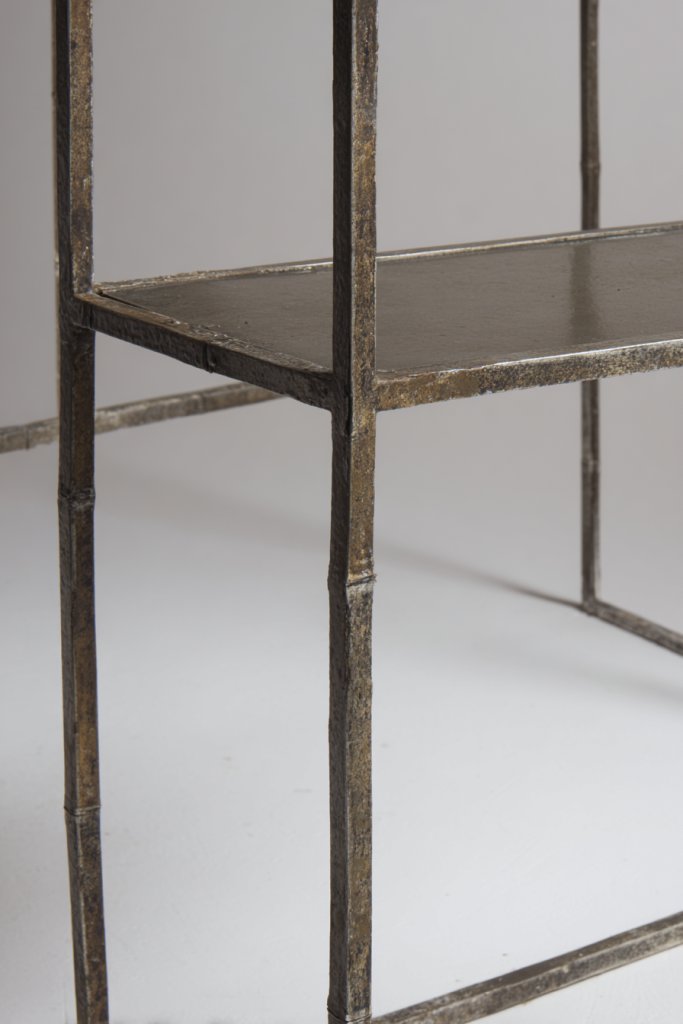
Looking to add a touch of understated industrial edge without losing warmth? Open-frame, worn metal or bamboo elements strike the perfect balance between raw and refined. They introduce subtle texture and character that complement the natural, imperfect aesthetic of Wabi-Sabi. Plus, these materials age beautifully over time.
Picture a metal shelving unit with a distressed, matte finish or a bamboo room divider with visible joints and natural imperfections. The open-frame design keeps the space feeling airy and uncluttered, while the worn finishes add a layer of history. These elements blend seamlessly with soft textiles and muted tones, creating a layered, textured environment that feels both modern and rustic.
Use metal or bamboo for shelving, room dividers, or light fixtures in both contemporary and rustic interiors. For a softer look, pair with woven textiles or raw wood furniture. Seasonally, swap out soft textiles or add natural fiber baskets to maintain a cozy, earthy vibe. These elements work well in small spaces or as statement pieces in larger rooms.
Select open-frame metal or bamboo pieces with a distressed or aged finish for authenticity. Mount or position them securely, ensuring they harmonize with your room’s layout. For metal, consider applying a rust patina for extra character. For bamboo, keep it clean and avoid overexposure to moisture. Use simple tools to assemble or modify pieces as needed. Regular maintenance involves gentle cleaning and checking for stability.
Add personal touches by combining metallic or bamboo elements with handcrafted textiles or simple ceramics. Incorporate vintage or distressed hardware to reinforce industrial charm. Use these pieces to display curated objects like books, textiles, or sculptural decor—keeping the overall look minimal and intentional. The goal is to evoke a sense of history and craftsmanship.
Open-frame metal and bamboo elements embody the imperfect, transient beauty of Wabi-Sabi. They create visual interest without overwhelming the space. Over time, they develop a patina that enhances their character and appeal. Trust in these materials to add a subtle, grounded industrial vibe that complements your authentic aesthetic.
12. Design a Zen-Inspired Nook with Low Seating and Natural Textures
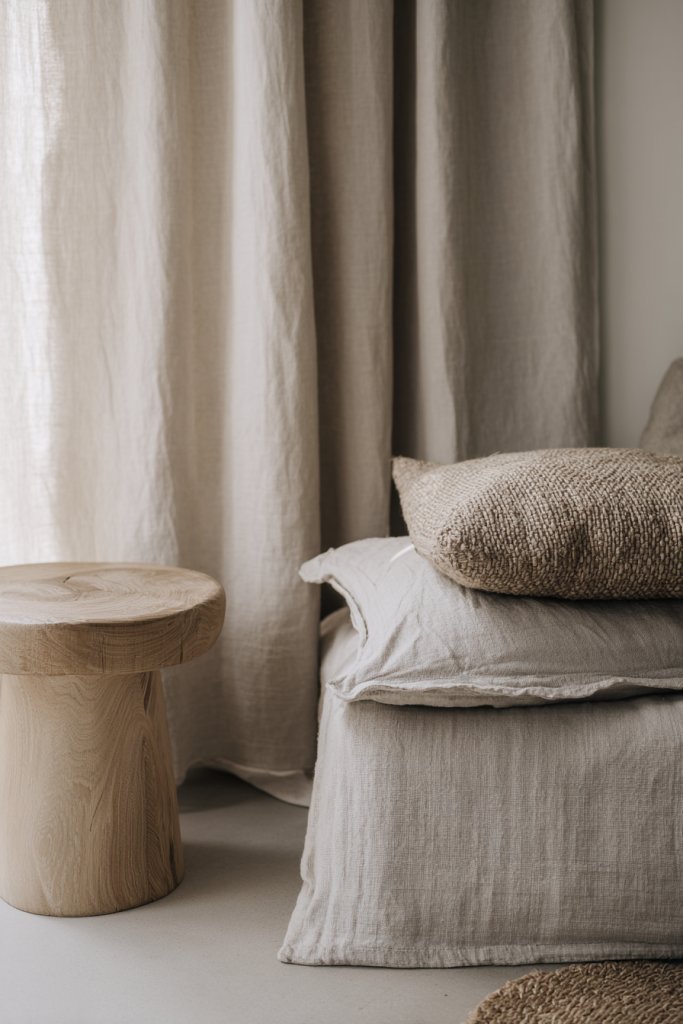
Craving a quiet corner to meditate, read, or simply breathe? A Zen-inspired nook offers a sanctuary of calm within your living space. Using low seating and natural textures creates a grounding environment that promotes mindfulness and relaxation. It’s your personal retreat to reset amidst everyday chaos.
Visualize a cozy corner with a low wooden platform or floor cushion surrounded by textured textiles and natural materials. Soft, earthy tones dominate, with a simple side table made from reclaimed wood. The space is uncluttered, with only a few carefully chosen elements that evoke nature’s serenity. Natural light filters in gently, creating a peaceful glow.
Use tatami mats, woven cushions, or low-profile seating to suit your space. Decorate with natural materials like stone, wood, or textured fabrics. Seasonal changes could include adding a small, handwoven blanket or a set of textured throws in warm tones. Keep the overall design minimal to maintain clarity and calm.
Choose low-profile seating options such as tatami mats, floor cushions, or simple wooden stools. Use natural fiber rugs or mats to define the space. Keep surfaces clear of clutter—just a small side table or a textured tray for essentials. Lighting should be soft, perhaps with paper lanterns or indirect light sources. Focus on creating a balanced, harmonious environment that invites stillness.
Incorporate personal items like a handcrafted incense holder or a simple ceramic bowl for offerings. Add textured textiles, such as a handwoven blanket or cushion covers, to underline the tactile theme. Use natural elements like stones or driftwood as decorative accents nearby. The goal is a space that feels naturally complete and calming.
A Zen nook fosters mindfulness and peace, transforming your home into a sanctuary. It’s a reminder that simplicity and natural textures foster genuine relaxation. Trust in the process of creating a space that nurtures your well-being—your personal retreat awaits.
13. Layer Different Shades of Beige, Taupe, and Gray for a Harmonious, Monochrome Palette
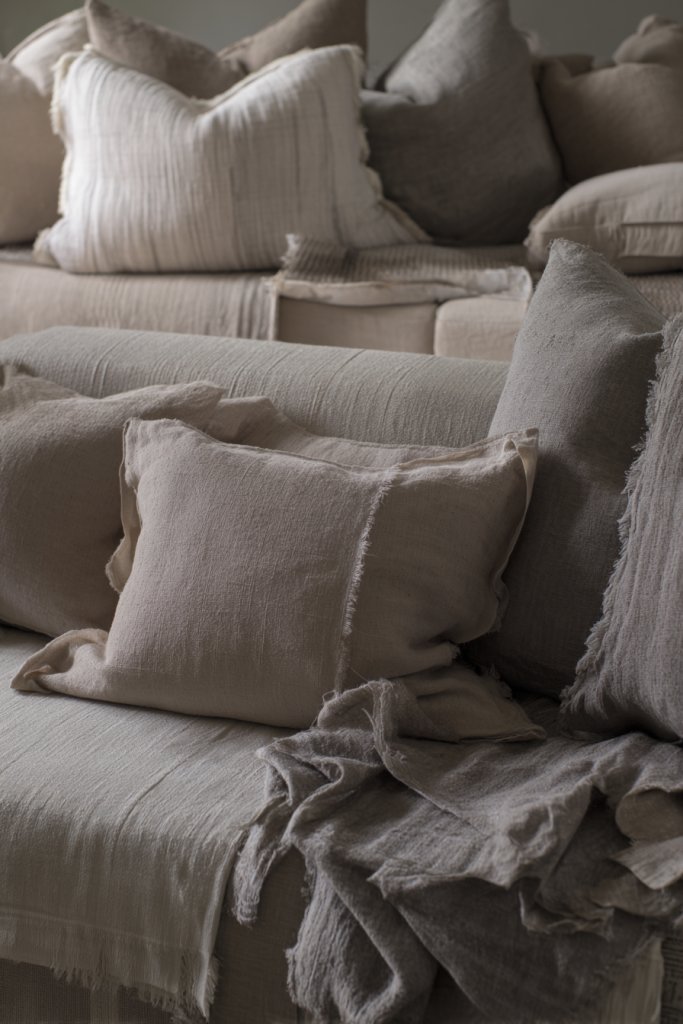
Feeling overwhelmed by overly colorful or busy decor? A monochrome palette with shades of beige, taupe, and gray offers a soothing, cohesive look. It creates a serene backdrop that emphasizes textures and forms without visual clutter. Perfect for those who crave calm and subtle elegance.
Imagine a living room where textiles, furniture, and walls blend seamlessly in soft, muted shades. The subtle variations in color add depth, while textured fabrics and natural materials catch the light differently, creating a layered visual effect. The space feels harmonious, quiet, and inviting—like a gentle embrace. It’s a palette that ages gracefully and remains timeless.
Mix matte and woven textures—think linen curtains, wool throws, and textured upholstery—to add visual interest. Incorporate natural wood, stone, or ceramic accents to enhance tactile richness. Seasonally, introduce warmer or cooler shades within the same palette, or add subtle metallic touches for contrast. Keep the overall look simple but layered for maximum calming effect.
Select a core color scheme and build from there, choosing textiles and furniture in matching shades. Use different textures to create visual interest—think boucle, raw silk, or chunky knits. Keep the palette consistent across walls, upholstery, and accessories, avoiding jarring contrasts. Use natural lighting to highlight the subtle shifts in tone and texture. Regularly refresh textiles for longevity and freshness.
Personalize with textured cushions, throws, or subtle decorative trims in similar hues. Incorporate natural wood or stone decor in warm tones to add depth. Add a few handcrafted items or vintage pieces to deepen the character. The focus remains on creating a unified, calming environment that evolves with your style.
A monochrome palette provides a timeless foundation for your space, encouraging peace and mindfulness. It’s flexible enough to evolve with seasonal or personal changes. Trust in the subtle beauty of layered neutral shades—your space will feel both elegant and grounded, a true reflection of Wabi-Sabi philosophy.
14. Add Organic-Looking, Handwoven Textiles for Throws and Cushions
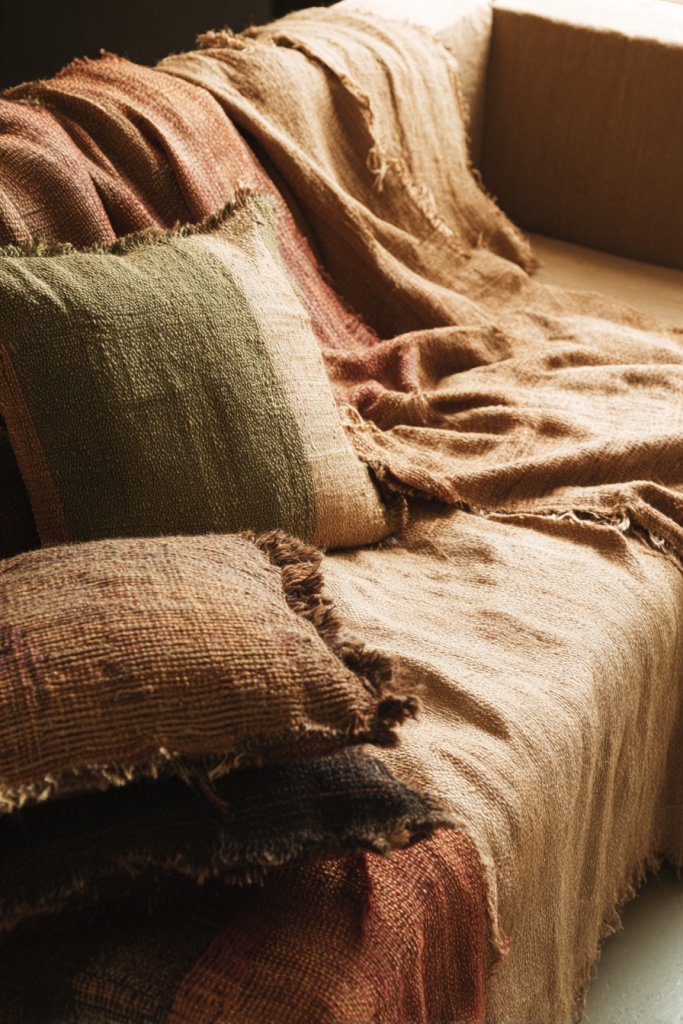
Tired of synthetic, mass-produced textiles that feel cold and uninspired? Organic-looking, handwoven textiles bring warmth, texture, and a personal touch to your living space. They embody the Wabi-Sabi ethos—beauty in imperfection and craftsmanship. Plus, they make your sofa or bed irresistibly cozy.
Picture a chunky, handwoven throw blanket in muted earth tones draped over a sofa. Pair it with cushions in textured weaves, perhaps with subtle irregularities or natural fibers. The tactile quality invites touch, while the irregular knitting or weaving adds visual interest. The overall effect is a cozy, inviting corner that feels both crafted and natural.
Combine different textures and natural fibers like wool, hemp, or cotton for layered appeal. Use cushions in various sizes and shapes for an eclectic, relaxed look. Change seasonal accents by swapping in lighter or heavier weaves or adding fringes and tassels. These textiles suit rustic, bohemian, or modern interiors, providing warmth and personality.
Source handmade or artisanal textiles, either locally or online. Mix and match textures—think woven, knitted, or fringed—to create visual depth. Drape throws over furniture or fold cushions neatly for a tidy yet inviting look. Regularly wash and care for textiles to maintain softness and appearance. Incorporate natural, undyed fibers whenever possible to stay true to the organic aesthetic.
Add personal touches by choosing textiles with subtle embroidery or hand-dyed details. Use cushions with irregular shapes or textures to enhance the handcrafted vibe. Incorporate a few vintage or heirloom textiles for added history. Layering multiple textiles creates a rich, tactile environment that encourages relaxation and touch.
Organic, handwoven textiles celebrate craftsmanship and natural beauty, making your space feel authentic and warm. They age beautifully, developing a unique character over time. Trust in their imperfect charm to create a cozy, inviting environment that feels truly yours—perfect for unwinding and recharging.
15. Integrate Simple, Unadorned Storage Bits Like Woven Baskets or Jute Sacks
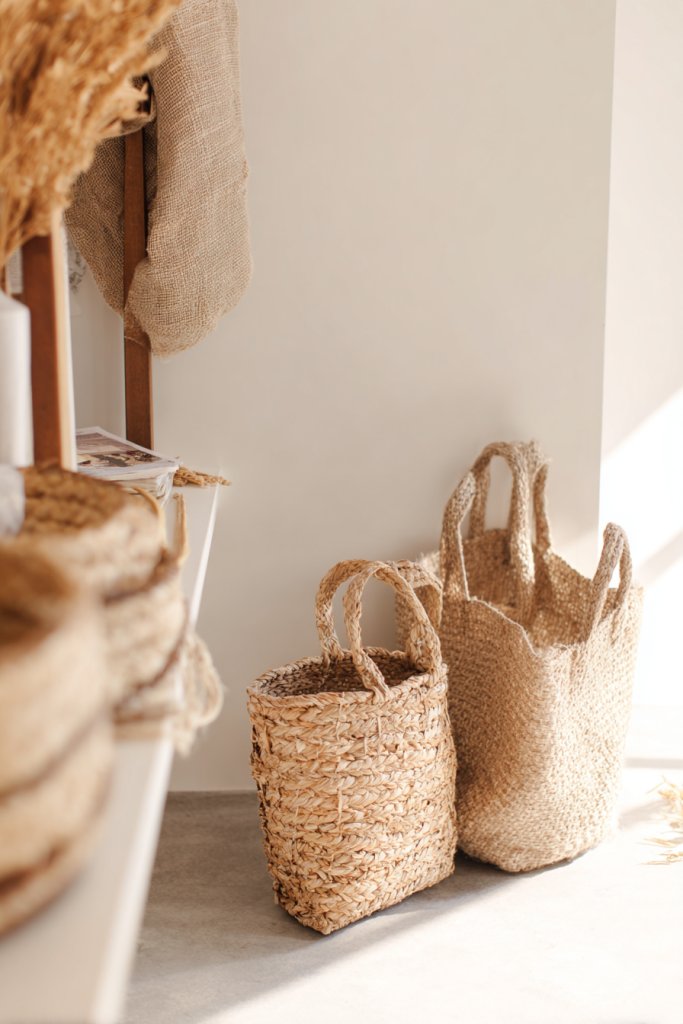
Clutter is the enemy of tranquility. Simple storage solutions like woven baskets and jute sacks offer a functional yet aesthetic way to keep your space tidy. They’re unobtrusive, eco-friendly, and add a natural texture that aligns perfectly with Wabi-Sabi principles. Who said storage can’t be beautiful?
Imagine a corner with open baskets filled with cozy blankets or magazines, their rough textures adding visual warmth. Jute sacks hang from hooks or sit on shelves, slightly wrinkled and imperfect, adding to the organic vibe. The neutral tones blend effortlessly with natural wood furniture and textured textiles, creating a relaxed, organized environment. It’s all about simplicity and function.
Use baskets and sacks in different sizes and shapes to accommodate various needs—store throws, toys, or magazines. Seasonally, switch from lighter jute to heavier, woven options for warmth. Place them strategically near seating areas or under tables to maintain accessibility. Keep the design minimal, letting the textures speak for themselves.
Choose natural fiber baskets or sacks from local artisans or eco-conscious brands. Use them to corral clutter in a visually appealing way. Securely place or hang them to avoid tipping or falling. Regularly clean and fold or rearrange to keep the look fresh. Incorporate them into your overall decor by matching their tones with other natural elements.
Personalize with hand-painted tags or markings, or add small decorative charms. Use textiles like wool or linen inside for added softness or insulation. Layer with a few vintage or textured cushions to soften the overall look. These storage bits become part of your decor story—functional art that’s both simple and charming.
Unadorned storage solutions remind us that functionality and beauty can coexist effortlessly. They help maintain a calm, organized space while adding natural texture. Over time, they develop a weathered, lived-in patina that enhances their charm. Trust in simple, honest storage to keep your home serene and clutter-free.
16. Use Vintage or Flea Market Finds to Enhance Wabi-Sabi’s Imperfect Charm
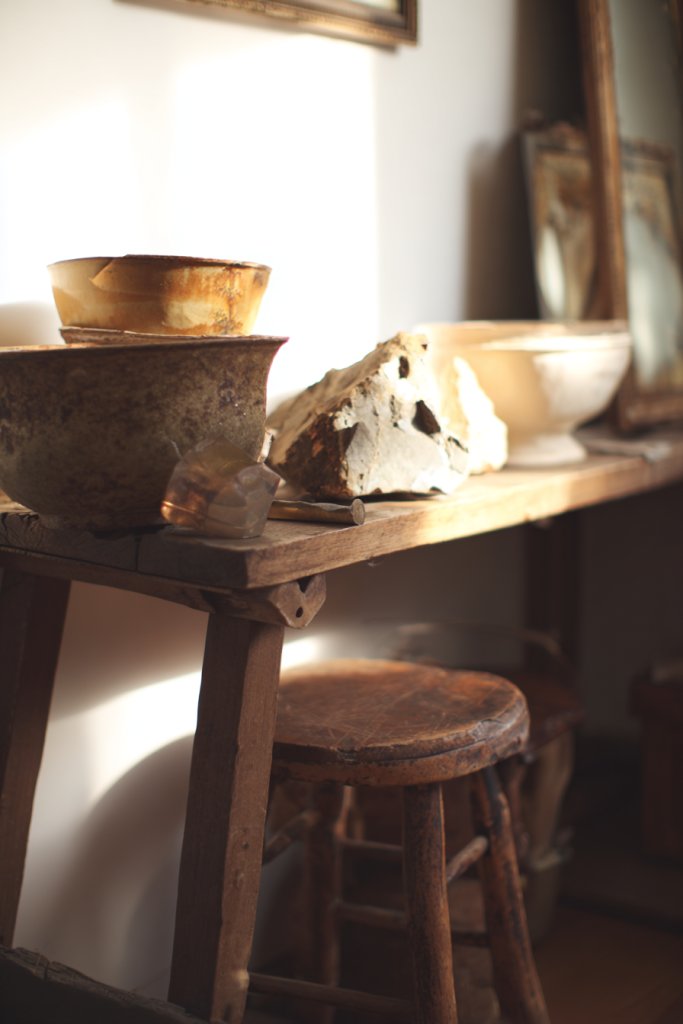
Looking for authentic pieces that tell a story? Vintage and flea market finds are treasure troves of imperfection, history, and character. They add a layer of depth and uniqueness to your space that mass-produced items simply can’t match. Plus, hunting for these gems is half the fun.
Picture a weathered wooden mirror with peeling paint, or a tarnished brass tray with dents and scratches. These items sit among textured textiles and handcrafted ceramics, creating a curated collection of aged beauty. The imperfect details evoke nostalgia and authenticity, transforming your living room into a space full of stories and soul.
Mix vintage pieces with modern furniture for contrast, or keep everything in a similar era for a cohesive vintage aesthetic. Incorporate flea market finds in lighting fixtures, small sculptures, or decorative accessories. Seasonal updates could include swapping or adding to vintage collections, keeping the space fresh but rooted in history. The key is to curate thoughtfully, not clutter.
Visit local flea markets, antique stores, or online marketplaces—look for items with visible wear, patina, and imperfections. Focus on pieces that resonate emotionally or add texture. Clean and restore gently if needed, avoiding over-polishing. Arrange items intentionally, balancing their aged charm with your decor. Use these finds as focal points or layered accents to add depth.
Create a display vignette with vintage items—mixing textures, shapes, and eras. Personalize by adding a small handcrafted element or combining with modern pieces for contrast. Incorporate storytelling by sharing the history of each piece when entertaining. Let your vintage finds reflect your journey and aesthetic preferences.
Vintage and flea market treasures celebrate imperfection and history, perfectly aligned with Wabi-Sabi. They add warmth, authenticity, and a sense of discovery to your home. Over time, these pieces develop a richer patina, becoming cherished parts of your living environment. Trust in the beauty of aged, imperfect objects to inspire your space.
17. Create a Serene Corner with a Floor Cushion and a Small Side Table for Reflection

Ever wish you had a dedicated space for quiet reflection or meditation? A simple, serene corner with a floor cushion and a small side table can be your personal retreat. It’s a low-maintenance, inviting setup that encourages mindfulness and calm. Small changes like this can make a big difference in your daily routine.
Imagine a soft, textured cushion in muted tones placed on a natural fiber rug. A small wooden or ceramic side table sits nearby, holding a handmade cup or a textured ceramic bowl. The space is uncluttered, with a few carefully chosen objects that evoke tranquility—perhaps a stone or a dried botanical. The overall vibe is cozy, grounded, and intentional.
Use floor cushions in neutral or earthy shades, layered with textured throws for comfort. The side table can be a simple wooden stool, a vintage crate, or a handcrafted ceramic piece. Add seasonal touches like a wool blanket or a textured cloth to shift the mood. Keep the space minimal, focusing on quality and simplicity.
Choose a comfortable, textured floor cushion or meditation mat made from natural fibers. Select a small side table that complements your decor—preferably wood, ceramic, or woven material. Place the setup in a quiet corner with natural light and minimal distractions. Keep the area clean and uncluttered, focusing on creating a peaceful environment. Add a soft light source if needed for evening reflection.
Personalize with a handmade or textured cushion cover, or add a small, crafted object that brings you joy. Use natural elements like a smooth stone or a dried flower for a tactile touch. Incorporate a textured throw or blanket to invite comfort. The goal is a space that feels both intentional and soothing, tailored to your needs.
A dedicated reflection corner nurtures mindfulness and self-awareness. It turns a simple space into a sanctuary that supports your well-being. Over time, it becomes a visual reminder to slow down and reconnect. Trust in the simplicity and natural textures to foster a sense of peace and clarity in your home.
18. Highlight Natural Light with Unobstructed Windows and Light Linen Curtains
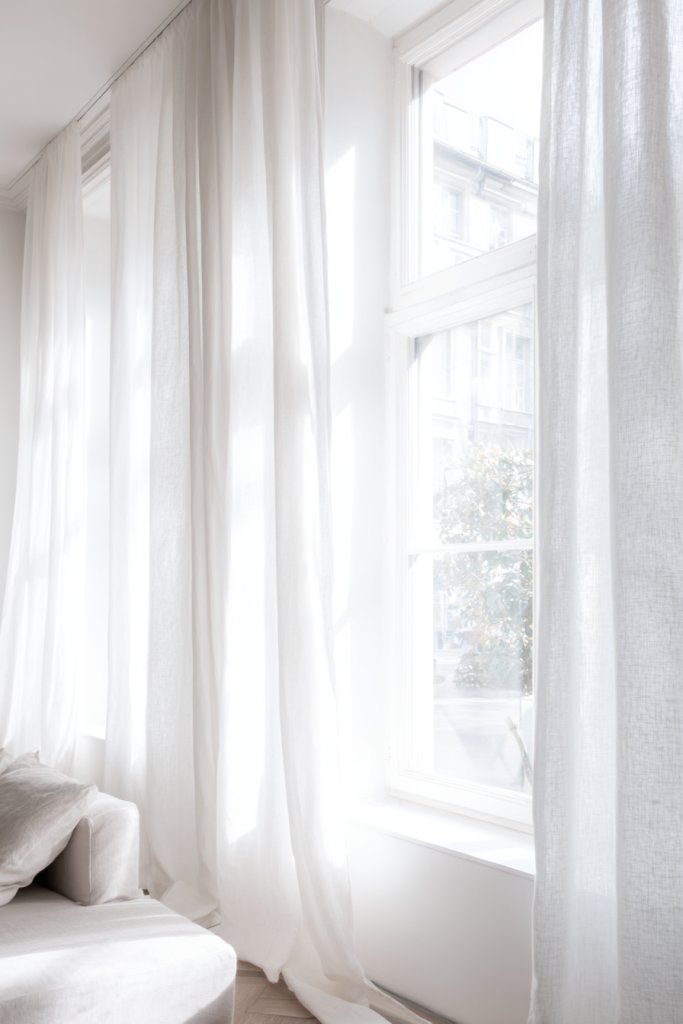
Harsh or obstructed windows block the gentle flow of natural light that makes a space feel alive. Creating an unobstructed view and using light linen curtains can transform your living room into an airy, calming retreat. It’s about amplifying what’s already there—nature’s best gift.
Picture large, unadorned windows with light linen curtains that gently diffuse sunlight. The fabrics shimmer softly, creating a glow that highlights textured walls and natural finishes. The light creates subtle shadows and emphasizes imperfections, adding depth and warmth. The overall atmosphere is open, bright, and inviting—like a breath of fresh air.
Keep window treatments minimal—think simple rods and soft, flowing curtains in neutral shades. For seasonal variation, layer with lightweight, breathable fabrics or add textured blinds. Position furniture to maximize views and light flow, and trim or clean window areas regularly to prevent obstructions. Use sheer curtains in summer and heavier linen for colder months, always maintaining an unobstructed view.
Choose light, natural fiber curtains that drape softly and filter sunlight without blocking it completely. Mount curtain rods close to the ceiling for a sense of height and openness. Keep windows clean and free of clutter, and consider removing heavy drapes or blinds that block light. Use simple, unobtrusive hardware to preserve the minimalist aesthetic. Regularly check for light leaks or obstructions to maintain the flow.
Personalize curtains with subtle embroidery or textured trims. Layer with a light, textured throw or cushion on nearby furniture to echo the airy feel. Incorporate natural elements like a small, handcrafted wooden or woven shade to add visual interest. The goal is to maintain a luminous, uncluttered environment that feels fresh and natural.
Maximizing natural light creates a space that feels vibrant yet peaceful. It encourages a connection with the outdoors and enhances the textures and colors within your home. Trust in the power of simple window treatments to elevate your entire environment—bright, airy, and full of life.
19. Incorporate Subtle, Textured Wall Hangings or Fabric Art in Earthy Hues
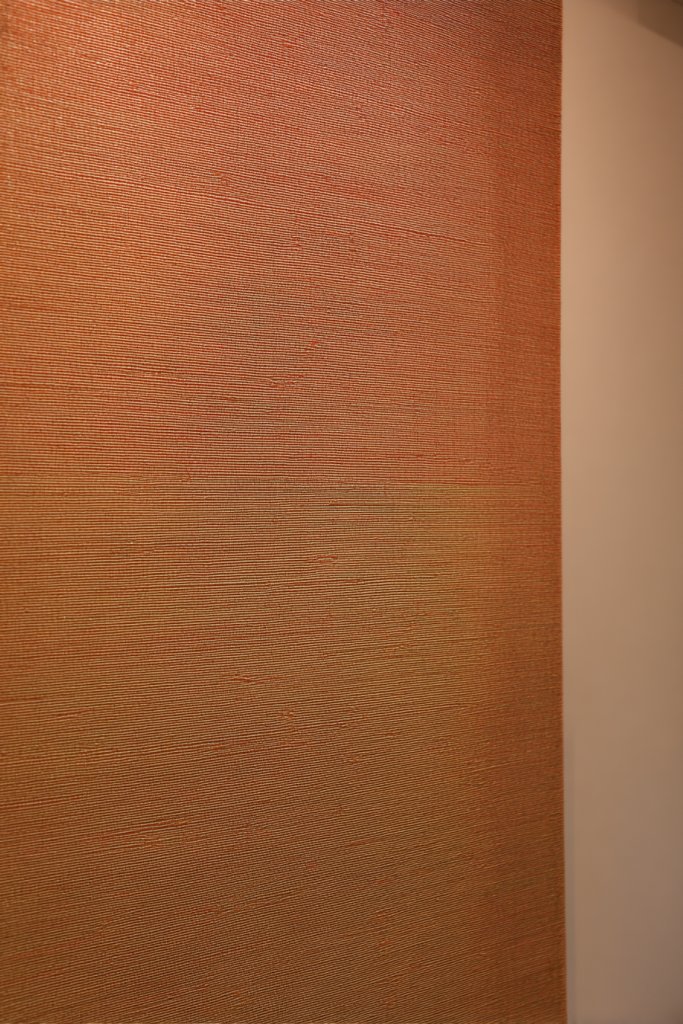
Plain walls can feel cold or disconnected from the rest of your cozy space. Subtle textured wall hangings or fabric art in earthy hues add depth and warmth without overwhelming. They’re an easy way to introduce tactile interest and a personal touch that aligns with Wabi-Sabi’s appreciation for imperfection.
Imagine a woven wall hanging with irregular, hand-stitched patterns in muted browns and greys. Its textured surface catches the light, creating shadows and visual depth. Nearby, a piece of raw linen fabric with subtle pleats adds softness and organic texture. Together, these elements evoke a sense of craftsmanship and natural beauty, enriching the room’s tactile landscape.
Use large, simple textiles for a statement piece or multiple smaller pieces for a layered gallery wall. Change them seasonally or with your mood, swapping out lighter fabrics for warmer textures or adding embroidered details. Keep the overall color palette neutral to maintain calm. Hang with simple rods or clips, avoiding overly ornate frames for a more authentic look.
Select textured textiles or woven pieces in earthy tones—preferably handmade or natural fibers. Mount or hang them using simple, unobtrusive hardware, ensuring they are taut but not stretched. Regularly dust or gently clean to preserve their texture and appearance. Incorporate contrasting textures nearby, like rough wood or smooth ceramics, to enhance tactile richness.
Add personal touches with stitched-in initials, subtle embroidery, or painted accents. Layer textiles with different textures and scales for visual interest. Use complementary colors or subtle metallic threads to add a touch of elegance. Keep the overall display minimal and intentional, emphasizing craftsmanship and natural materiality.
Textured wall hangings remind us that imperfection and tactility are beautiful. They add warmth and personality to your space, making it feel curated yet effortless. Trust in the understated beauty of fabric art to craft a calming, inviting environment—your home as a tactile sanctuary.
20. Choose Functional, Minimalist Pieces with Visible Wear for Character
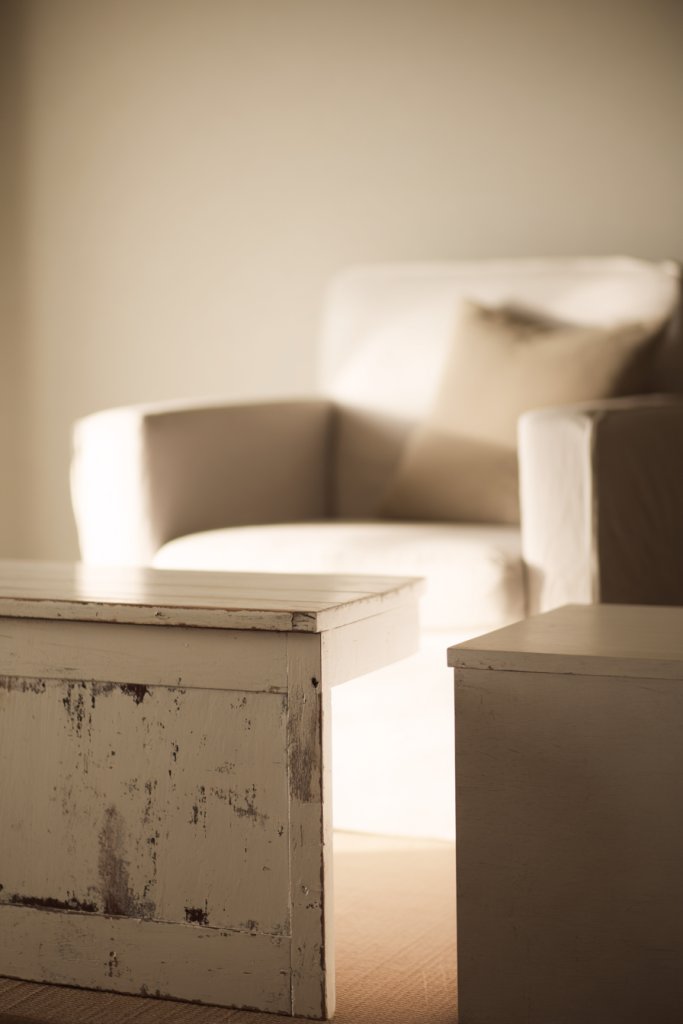
Overly polished or brand-new furniture can feel out of place in a Wabi-Sabi-inspired space. Functional, minimalist pieces with visible wear bring a sense of history and authenticity. They tell a story of use and patience, adding character without clutter. It’s about celebrating the beauty of aging gracefully.
Picture a simple wooden side table with a worn finish, showing patches of raw wood where paint has chipped. A sleek metal chair with scratches and patina sits nearby, exuding a quiet strength. These pieces look like they’ve been part of a life well-lived, adding depth and warmth to your decor. Their imperfections make the space feel genuine and lived-in.
Prioritize quality, functional furniture with signs of aging—think distressed leather sofas, aged metal frames, or vintage cabinets. Mix with modern textiles or accessories to create contrast. Keep the wear visible, avoiding over-restoration, to preserve their character. Seasonal styling can include adding textured throws or cushions that complement their aged appearance.
Choose pieces with natural wear or intentionally distressed finishes from antique or vintage sources. Maintain their aged look by avoiding over-polishing; instead, gently clean with soft cloths. Incorporate these items into your space as focal points or supporting accents. Use natural oils or waxes to enhance wood aging, but avoid modern glossy finishes. Regular maintenance keeps their character intact.
Add personal touches like engraved initials or subtle paint touches that age naturally. Pair with textured textiles or handcrafted accessories to amplify the character. Use these pieces as anchors in your decor, balancing them with more refined elements for visual harmony. The imperfections become a conversation starter and a testament to beauty in imperfection.
Functional, worn furniture embodies the Wabi-Sabi philosophy—beauty in aging and imperfection. They create a space that feels authentic and rooted in history. Over time, these pieces develop a richer patina, deepening their charm. Trust in their character to craft a warm, inviting environment full of soul.
21. Keep Decor Simple and Intentional by Removing Excess for a Truly Serene, Wabi-Sabi Space
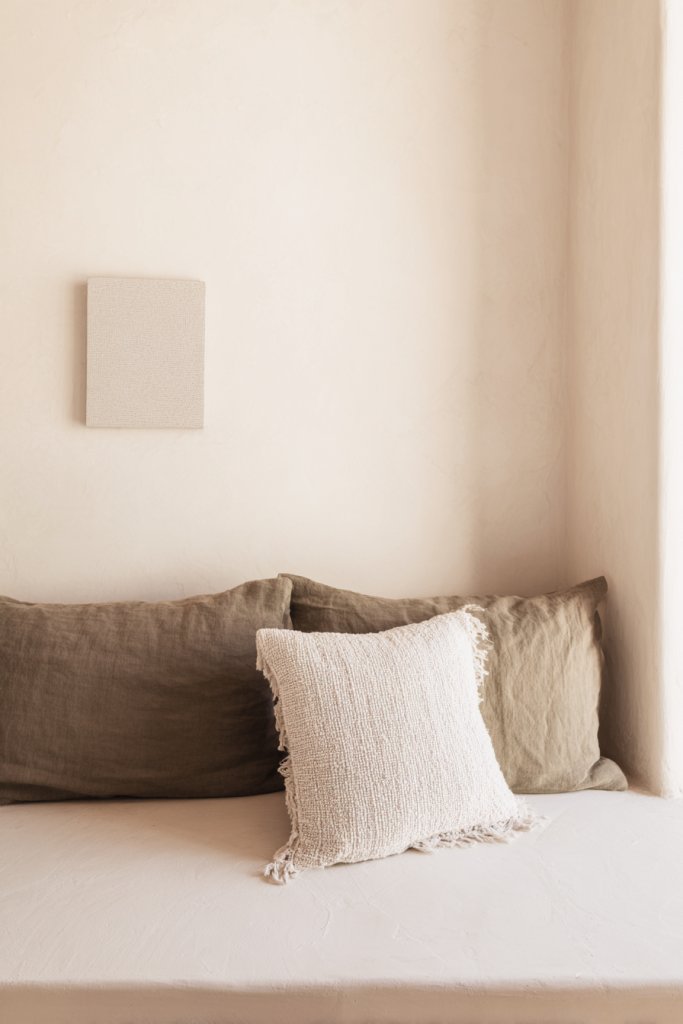
Clutter can make even the most beautiful space feel chaotic. A minimalist, intentional approach to decor encourages calm and clarity. It’s about removing the unnecessary and focusing on what truly matters—creating a home that feels peaceful and authentic. Less truly is more, especially in Wabi-Sabi living.
Picture a room with only a few carefully chosen objects—perhaps a textured ceramic piece, a simple wooden tray, and a soft textile. The space feels uncluttered, with plenty of open space that invites the eye to rest. Natural light filters through lightly textured curtains, emphasizing the beauty of emptiness and balance. It’s a space that breathes simplicity and purpose.
Regularly reassess your decor, removing items that no longer serve a purpose or bring joy. Keep surfaces clear and only display a few meaningful objects. Seasonal swaps or rotations keep the space fresh without clutter. Focus on quality over quantity—each piece should add value and beauty.
Start by decluttering, then organize what remains in a way that emphasizes space and simplicity. Use storage solutions that blend into your decor—think woven baskets or hidden compartments—to keep surfaces tidy. Choose a neutral or earthy palette to reinforce calmness. Maintain a habit of editing regularly to prevent accumulation of unnecessary items.
Add personal touches with handcrafted or vintage items that reflect your journey. Use textures and materials that evoke natural beauty, such as raw wood, linen, or stone. Keep your decor intentionally sparse, highlighting the beauty of each piece and the space itself. Let your environment be a daily reminder to embrace simplicity.
A clutter-free, intentionally decorated space cultivates peace and mindfulness. It allows your true personality and aesthetic to shine through effortlessly. Over time, you’ll find that less truly is more—your home becomes a sanctuary that nurtures your soul and sense of calm. Trust in the power of simplicity to transform your living experience.
Conclusion
By exploring these diverse Wabi-Sabi Living Room Ideas, you can easily transform your home into a peaceful retreat filled with natural textures, muted tones, and meaningful accents. Don’t hesitate to try these inspiring concepts and infuse your space with authentic beauty. Embrace the imperfect, and let your living room become a sanctuary of serenity and soulful charm.